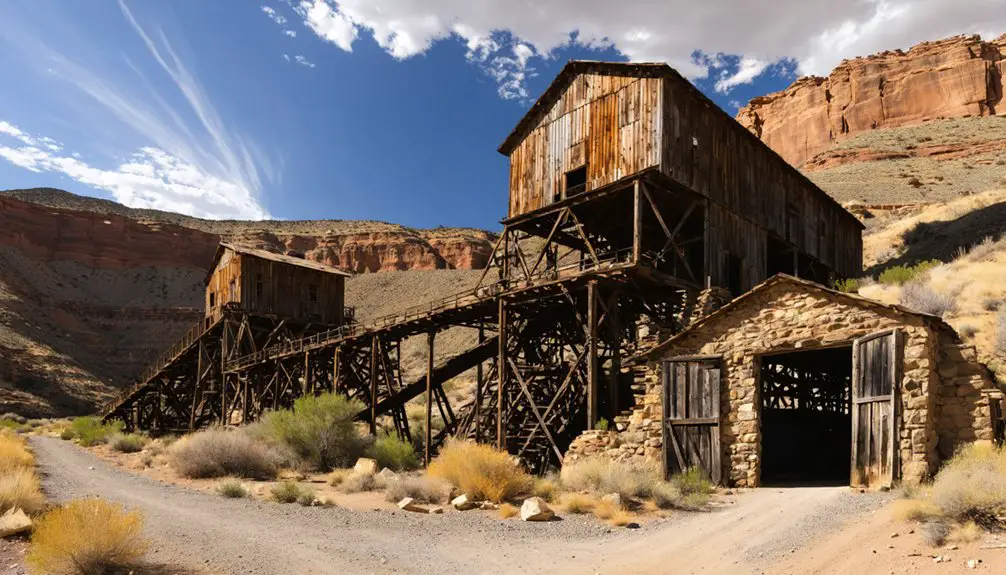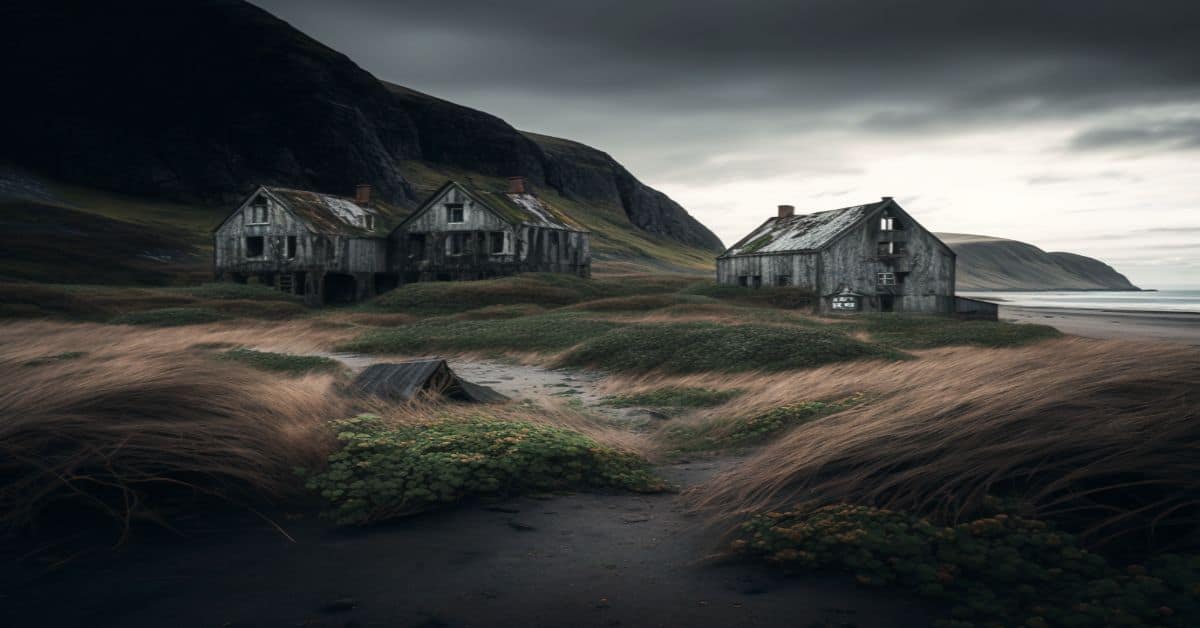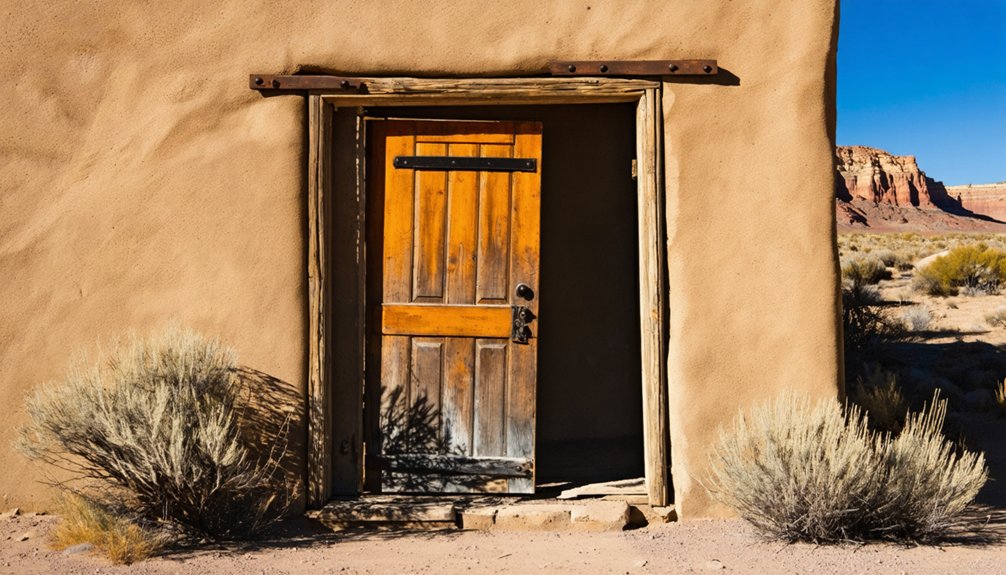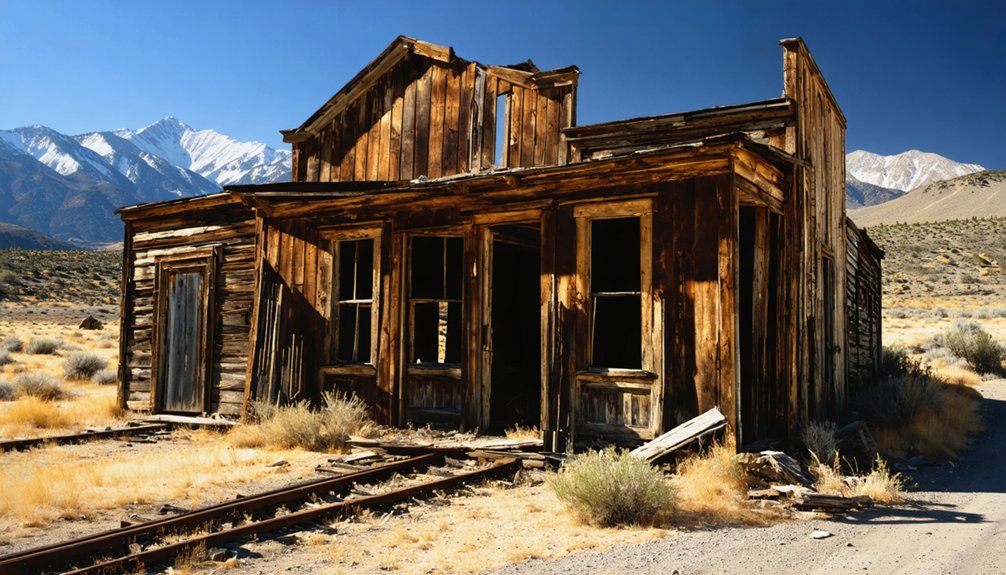You’ll discover the remnants of Utah’s largest ghost town in Emery County’s Castle Valley coal mining district, where Mohrland once thrived with over 1,000 residents. Founded in 1907 by four investors who combined their initials to name the town, it featured two major mines, 200 homes, a hospital, and a bustling community life. After the mines closed in 1925 and the Great Depression hit, the town declined until its abandonment in 1938. The town’s foundations, walls, and railroad traces hold countless untold stories.
Key Takeaways
- Mohrland is Utah’s largest ghost town, established in 1907 as a coal mining community that peaked with nearly 1,000 residents.
- The town thrived until 1925 when U.S. Fuel Company abruptly closed the mine, leading to eventual abandonment by 1938.
- Seventeen miners lost their lives between 1910-1938, contributing to the town’s decline and eventual ghost town status.
- Today, visitors can explore building foundations, standing walls, and old railroad lines from the abandoned mining community.
- The town’s buildings were sold for $50 each during its decline, leaving only remnants of its once-bustling infrastructure.
The Birth of a Coal Mining Company Town
Four ambitious investors laid the foundation for Mohrland in 1907 when they purchased a small coal mining operation in Cedar Creek Canyon, Utah. Mays, Orem, Heiner, and Rice formed the Castle Valley Fuel Company, embedding their initials into the town’s name as a symbol of their entrepreneurial vision.
While local miners had extracted coal for home heating since before 1896, the new company structure transformed the operation into a commercial enterprise. The investor dynamics sparked rapid development, with the first major coal shipments leaving Mohrland in April 1910. The mine faced typical challenges of the era, including dangerous working conditions that put miners at constant risk.
Under their leadership, what began as a modest mining venture evolved into a planned company town. The community flourished with over 200 homes built to accommodate the growing workforce. This bold venture caught the attention of the United States Fuel Company, which acquired Mohrland in 1915, further expanding its coal mining empire in the region.
Life in Early 20th Century Mohrland
As Mohrland evolved from a modest mining operation into a bustling company town, its population swelled to nearly 1,000 residents by the early 1920s.
You’d find over 200 houses, a hospital, post office, and a four-room schoolhouse serving the community. The town’s social events centered around a large amusement hall, where you could enjoy dances and film showings organized by the company. Monthly residents’ fees supported entertainment and medical services. The miners extracted coal from three thick veins totaling sixty-three feet in depth.
The town’s pride was its baseball team, which drew massive crowds and even played an exhibition game against the Chicago White Sox in 1915.
Baseball was more than a game in Mohrland – it was a symbol of community pride, reaching its peak in a legendary White Sox matchup.
Despite the hazards of mining life – with seventeen fatalities between 1910 and 1938 – the company invested in worker safety through annual first aid training and medical services.
Tree-lined streets and ethnically diverse neighborhoods made this desert-edge community feel like home.
Mining Operations and Economic Impact
When you examine Mohrland’s mining operations from 1910 to 1925, you’ll find two major mines, King No. 1 and King No. 2, extracting coal from impressive 17-foot seams using wagon transport in the early years.
The mines’ technological evolution included the significant switch from the Southern Utah Railroad to the more capable Utah Railway, which better handled the region’s challenging gradients and increased coal shipment efficiency. Prior to 1945, most coal operations in the region were small-scale mines shipping only 50-100 tons per day.
Your understanding of the operation’s scale comes into focus when you consider that at its peak around 1920, the mines supported nearly 1,000 residents while providing steady employment through the United States Fuel Company.
Mining Equipment and Technology
Mining operations at Mohrland showcased significant technological advancements during the early 20th century, transforming the site into a highly mechanized coal production center.
You’d find machine undercutters revolutionizing coal extraction techniques, while four-ton wooden and steel mine cars hauled the precious cargo through the tunnels. Similar to Jonas Lie’s paintings that captured the epic scale of mining, the Mohrland site demonstrated impressive industrial achievement.
The site’s impressive 7,000-foot double-track gravity tramway, featuring a 9% downward grade, efficiently moved coal to the tipple. Electric locomotives, including three Goodman 12-ton and one 6-ton models, powered the underground haulage system.
Castle Valley Coal Company originally established the mine in Cedar Creek Canyon, laying the foundation for decades of coal production.
Coal Production and Employment
Since its humble beginnings in Cedar Creek Canyon before 1896, Mohrland’s coal production evolved from small-scale local heating operations into a thriving commercial enterprise.
By 1910, Castle Valley Fuel Company launched commercial shipping, transforming labor relations as independent claim miners gave way to corporate employment.
You’ll find that at its peak in 1922, the mine employed 275 men, supporting over 1,000 residents through robust economic resilience.
The workforce included multigenerational mining families, with union membership providing some worker protections.
U.S. Fuel Company’s takeover in 1915 brought both stability and vulnerability – while the company funded stores, medical services, and community venues, it also held complete economic control.
This power became evident when they abruptly closed the mine in 1925, triggering mass unemployment and the town’s eventual decline.
Daily Routines of Miners and Their Families
Life in Mohrland’s coal mining community revolved around the demanding schedules of underground work, where miners spent grueling days operating cutting machines, drilling blast holes, and driving shuttle cars through humid tunnels at 8,000 feet elevation.
Deep underground at Mohrland, miners endured punishing days drilling, cutting, and navigating shuttle cars through humid tunnels high in the mountains.
You’d find miners’ family dynamics shaped by long workdays, including Sundays, leaving precious little downtime. After exhausting shifts, evenings centered on meal preparation and helping children with schoolwork. The miners would arrive early each morning to retrieve their dry work clothes from special storage rooms before beginning their shifts. The local schoolteacher earned $80 a month to educate the diverse group of miners’ children.
Saturdays meant tackling essential chores like washing and ironing clothes. The diverse immigrant households – Greek, Italian, Japanese, and Austrian – created vibrant community traditions.
You’d see families gathering at the schoolhouse for dances and musical events, while baseball games offered both entertainment and extra wages for participating miners. Local vendors, from Greek bakers to Italian milkmen, served their respective ethnic communities, maintaining cultural connections in this high-altitude mining town.
The Rise and Fall of Utah’s Largest Coal Camp
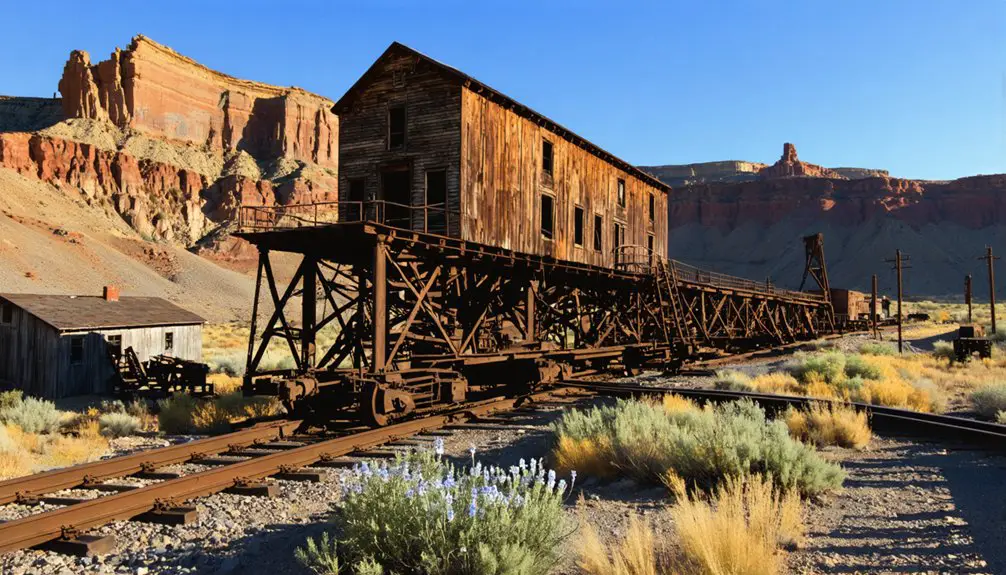
If you’d visited Mohrland in 1907, you’d have witnessed the Castle Valley Fuel Company‘s ambitious transformation of Cedar Creek Canyon into Utah’s largest coal camp, complete with over 200 houses, an amusement hall, and a thriving business district.
By the early 1920s, under Utah Fuel Company’s ownership, Mohrland reached its peak with nearly 1,000 residents enjoying tree-lined streets, organized baseball games, and modern amenities like a hospital and company store.
The town’s dramatic end came in 1938 when the mine closed, leading to swift abandonment as buildings were relocated and workers dispersed, leaving behind only memories and old rail lines in the canyon.
Mining Company’s Grand Vision
After discovering promising coal deposits in Cedar Creek Canyon, four ambitious investors formed the Castle Valley Fuel Company in 1907, laying the foundation for what would become Utah’s largest coal camp. Their company vision transformed a rugged canyon into a thriving community with modern infrastructure, designed to support both mining operations and quality of life for workers.
- Streets lined with shade trees and a flowing stream created an oasis in the isolated canyon.
- A complete business district, hospital, school, and amusement hall provided essential services.
- Modern mining equipment, including Joy loaders and beltlines, maximized coal production.
You’ll find their ambitious planning reflected in every aspect of Mohrland’s development, from the extensive worker housing to the installation of railroad connections that began steady coal shipments by 1910.
Their investment in mine safety training and social amenities demonstrated a commitment to building more than just a mining operation.
Booming Community Life 1907-1938
The bustling coal camp of Mohrland emerged as Utah’s largest mining settlement during its peak years between 1907 and 1938. You’d have found over 1,000 residents living in 200 houses spread across ethnically diverse neighborhoods, with a thriving business district that included stores, saloons, and a hospital.
Life wasn’t just about work in this company town. You could’ve enjoyed regular community events at the large amusement hall, watched films, or cheered for Mohrland’s championship baseball team – which even faced the Chicago White Sox before 10,000 spectators in 1915. A four-room schoolhouse served the community’s children.
The mining company invested in creating an appealing environment, lining streets with shade trees and maintaining the creek. Despite the dangers of mining life, which claimed 17 lives between 1910-1938, the town fostered a vibrant multicultural community spirit.
Sudden Abandonment and Legacy
Life in Mohrland changed dramatically when U.S. Fuel abruptly closed the mine in March 1925, leaving residents without warning, income, or credit at the company store.
Though the mine reopened in 1926, showcasing the community’s resilience, declining coal prices during the Great Depression forced residents to adapt economically.
By 1935, U.S. Fuel connected Mohrland to Hiawatha mine, signaling the beginning of the end.
- Buildings were sold for just $50 each to salvage companies, erasing most physical traces.
- Population dropped steadily from 620 in 1930 to near zero by the final closure in 1938.
- Mining dangers claimed 17 lives between 1910-1938, reflecting the harsh realities of coal camp life.
Today, Mohrland stands as Utah’s largest ghost town, a stark reminder of industrial boom-bust cycles and community vulnerability.
Exploring the Ruins Today
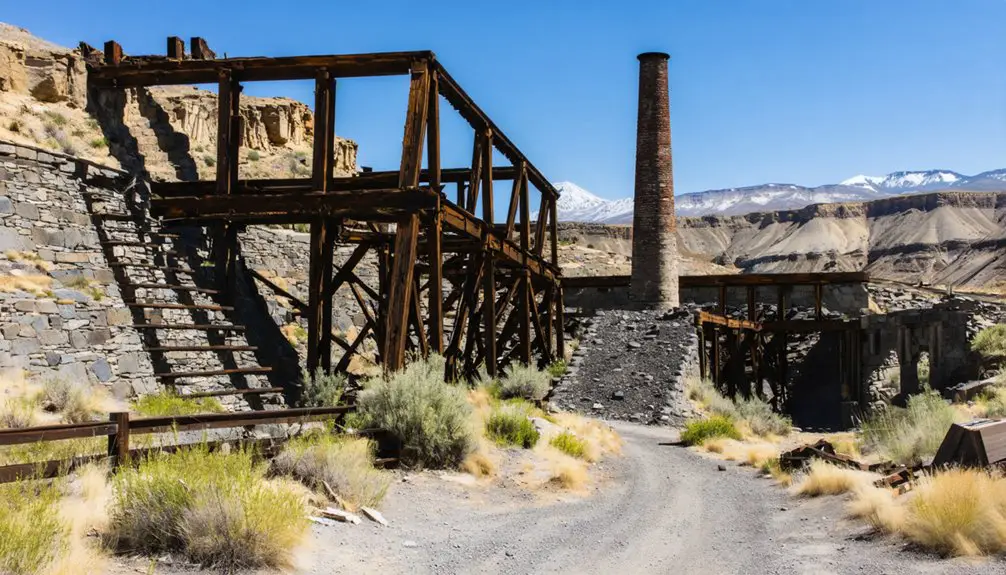
Modern visitors to Mohrland’s ghost town encounter a stark landscape where nature steadily reclaims what was once Emery County’s largest coal mining settlement. At 7,185 feet elevation in Cedar Creek Canyon, you’ll discover building foundations, standing walls, and the old railroad line that tell the story of this once-thriving community.
During your ruins exploration, you can trace the town’s layout through remnants of the school, mine office, and store. The foundations along Silk Stocking Row and Gobbler’s Knob reveal the town’s social hierarchy and ethnic divisions.
For the best experience, visit during spring or summer when the 2-wheel drive roads are most accessible. Remember to bring water and hiking gear – there aren’t any amenities at this historically significant site where sagebrush now grows among the scattered remains.
Preserving Mohrland’s Mining Heritage
Since Mohrland’s decline in the late 1920s, preservation efforts have focused on protecting both the physical remnants and cultural legacy of this once-bustling coal mining town.
Through heritage preservation initiatives, you’ll find local historical commissions working to document and maintain the remaining mine portals, tram structures, and company buildings. Community engagement plays an essential role, with descendants of miners contributing family histories and photographs to local archives.
- The Western Railroad and Museum in Helper houses artifacts and company records from Mohrland’s mining operations.
- Oral history interviews capture firsthand accounts of daily life in the company town, including stories about the hospital, amusement hall, and baseball teams.
- Safety training documents and records of mining accidents help preserve the important legacy of worker conditions and labor relations.
Frequently Asked Questions
Are There Any Documented Paranormal Activities or Ghost Sightings in Mohrland?
You won’t find any documented ghost stories or paranormal investigations in this locale. Historical records, tour guides, and databases show no supernatural activity throughout the town’s mining history and abandonment.
What Happened to the Residents After the Town’s Abandonment in 1938?
Like migrating birds seeking new nests, you’ll find most residents flew to Hiawatha’s mines for work. The resident fate scattered families across Utah’s mining towns, though their community legacy endures in Emery County.
Were There Any Major Mining Accidents or Disasters in Mohrland?
While historical accidents occurred in nearby mines, you won’t find records of major mining disasters in Mohrland itself, though mining safety concerns existed with typical hazards like coal dust and methane gas.
Is Special Permission Required to Visit the Mohrland Ghost Town Site?
Yes, you’ll need special permission since the ghost town sits on private property. Visitor regulations require you to obtain landowner approval before exploring any remaining structures or mine-related sites.
What Valuable Artifacts Have Been Discovered in the Ruins of Mohrland?
While you’d expect gold to steal the show, it’s the Chinese artifacts that proved most significant: ancient currency, porcelain bowls, and food remains tell a deeper story through careful excavation techniques.
References
- https://en.wikipedia.org/wiki/Mohrland
- http://emerycountyarchives.blogspot.com/2010/10/mohrland-is-best-ghost-town-in-emery.html
- http://karenhikerchick.blogspot.com/2014/06/hiking-ghost-town-mohrland-utah.html
- https://www.onlineutah.com/mohrlandhistory.shtml
- http://ghosttowntour.blogspot.com/2014/05/mohrland-emery-county.html
- https://ogm.utah.gov/wp-content/uploads/2023/09/Rowleyfinal.pdf
- https://historytogo.utah.gov/the-coal-industry-in-heiner-utah/
- https://dp.la/item/ce2f7bd39f87ddac87f2e493d7819375
- http://historicalpreservation.blogspot.com/2011/08/mohrland-in-1906-william-howard-and-his.html
- https://utahrails.net/utahcoal/mohrland.php
